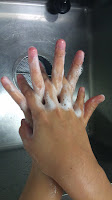In the kitchen, it is essential to have clean & accessory-free hands. Nails are to be short, clean, unvarnished & filed (minimum white part of the nails is visible). No biting of nails will be tolerated. This is to minimize the amount of crevices in between our nails for bacteria or food bits to be contained in. This way, the risk of microbial & physical contamination is largely reduced.
Microbial contamination occurs when microorganisms find their way into our food & causes food borne illnesses. Microorganisms are classified into 4 major categories, namely Bacteria, Viruses, Fungi & Parasites. An epitomical environment for them would have "FAT TOM", Food (ample nutrients), Acidity (an ideal pH), Time, Temperature, Oxygen (air) & Moisture. With these available, they will thrive. Once that happens, microbial contamination can easily occur with or without our knowledge.
Physical contamination occurs when inconsumable objects get into our food. Hence, it is vital to have our hands accessory-free at all times while working in the kitchen or dining hall. Only in the dining hall, watch is allowed, as there's no direct contact with the plate of food. If a watch is to be worn, it should be tightly adhered to your wrist & not be allowed to slide towards the hands.
Hair should be neat & restrained under our Chef's hat, minimum loose hair. Males & females with short hair should not have their hair touching the collar. For males, their hair should also not touch their ears. For ladies with long hair in the dining hall, they should either tie or bun their hair. All these is to prevent any hair from falling into the food.
Aprons have to be clean, as dirty aprons will most likely contain overwhelming throngs of bacteria that might still be growing. Starting every single day with clean, fresh aprons is highly encouraged, as we do not introduce any bacteria into the kitchen.
Safety shoes are very important, & everyone has to wear them. They not only keep our feet safe from dropping knives, they double up as an anti-slip device. Imagine wearing simple covered shoes; what would be left of our toes if a newly sharpened knife fell on our foot? I shudder to think of the consequences. Slippers and uncovered shoes are the bane of hygiene, as they constantly introduce halophiles into the open air. These microorganisms are able to tolerate up to 30% of salt, which makes them very hardy. Hence, safety shoes are a definite must have in the kitchen.
Cuts, sores & any infected wounds should be disinfected, applied with antiseptic and bound with detectable (green or blue), waterproof plasters. This is to prevent dressings being served undetected in food. If applicable, wearing a glove over the injury is highly encouraged to prevent it from dropping or adhering to handled food.
Separation of raw & cooked food should also be high on the priorities list, as mentioned in this post.
With this truckload of information, I shall end this post. I hope all of us will now be able to utilize this information to work towards a safe & hygienic working environment. Please remember to check back again next week !









































